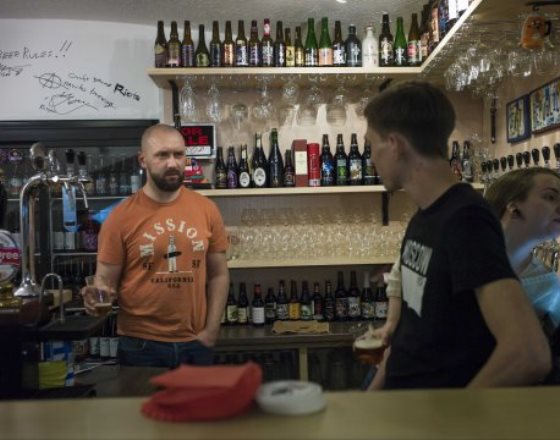
MOSCOW (AP) — Russia's ruble is on a roller-coaster. After being the world's second worst-performing currency against the dollar last year, it is among the best in 2015.
That will help keep a leash on inflation, to the relief of millions of Russians. But it is worrying one part of the economy — the local industry that had seen demand grow for its Russian-made goods when the falling ruble made imports hugely expensive.
Russian sectors, from building materials to craft beer, took advantage of the ruble's drop to undercut better-known imported rivals and gain a bigger domestic market share.
Nikita Filippov, co-owner of a St. Petersburg-based craft brewery, says it was a godsend.
"European beers finally hit the price roof, and bar owners realized that they can't raise their menu prices any more as the beer would become unaffordable," he says. "That was a crucial moment when the bar owners had to reconsider their profit margins for the first time in many years, and that was the time when they turned their faces to local craft breweries."
The government has championed such trends, hoping to get something out of the ruble's dramatic drop last year. One focus is the construction materials sector, as the country prepares to build World Cup venues. Oil companies were also helped, as they sell their product for dollars but have many expenses in rubles, helping to temper the financial pain from lower crude prices.
Now the currency is on the rise again and the government — which only months ago was desperately trying to support the currency — is intervening in markets to keep it from strengthening much further.
After plummeting to nearly 80 rubles against the dollar during panic selling in December, the ruble has recovered to trade at 52.6 per dollar on Friday. That's still means over a third below its level in January 2014, meaning local industry still enjoys some of their competitive advantage over imports.
Russian craft beers on tap, for example, sell for 150 to 200 rubles ($3-4) for a half-liter in Moscow bars compared with 300 rubles ($6) for the imported German and Belgian brands, which have up till now dominated the premium segment.
Demand for Russian craft beer is now twice as high as supply, Filippov estimates. He says costlier imported hops forced him to raise prices by 10-15 percent in December, but that rise is smaller than price hikes for imported rivals.
Stereotypically the preserve of American hipsters, craft beer entered Russia through St. Petersburg, the country's historic "window on Europe," but now some of the most popular brews come from unexpected places like the industrial Ural mountains city of Yekaterinburg or from Tula, better known for making the Russian army's rifles.
The ruble's recent rise has been helped mainly by a recovery in the price of oil, Russia's biggest money-making export, which has rebounded from lows of below $50 a barrel to around $60 a barrel. That's still only half the figure of a year ago.
A sharp increase in interest rates and deep budget cuts have also helped stabilize the currency. On the down side, the economy is still sliding into recession and the U.S. and European Union have shown no sign of letting up on the economic sanctions on Russia.
"If the oil price goes down or if, God forbid, there is further escalation in Ukraine or there is surprising news coming from the Russian economy, which is suffering, then the ruble can take a hit," says Sergei Guriev, a prominent economist and university rector who left Russia in 2013 after coming under pressure from the authorities.
Guriev says the Russian Central Bank has currency reserves worth $362 billion as of May 15 that it can use to influence the ruble's value. Whereas in December it was running down those reserves in an attempt to support the ruble, the central bank is now intervening in markets to stop the currency from strengthening too much, Guriev says. The bank does that by selling rubles and buying foreign currencies, effectively building its reserves up again.
Guriev says the central bank is under pressure from industry to limit the strength of the ruble.
"Imports were going down because of the weaker ruble. So strengthening the ruble too much would hurt this process," he said.
At the same time, he argues, keeping the ruble at a stable rate is reassuring for the public after months of turbulence, and is therefore "a politically important issue."
For the wider population, the ruble's drop pushed up inflation, which stood at 16.4 percent at last count, so some recovery in the currency is welcome. Above all, the country wants to avoid such big swings, as it makes it difficult for consumers and businesses to plan ahead. Some economists predict the ruble will remain between 50 and 55 to the dollar this year.
Stanislav Obraztsov, who runs a Moscow bar specializing in Russian craft beer, says that for all the help that a weaker ruble has brought to some local industries, companies cannot focus solely on currency markets but should look for the growth areas in the economy.
He's confident enough that craft beer will gain in popularity and become as big as in the U.S. that he's thinking of opening his own brewery.
"Over the next five years it's going to grow very powerfully."
original source: http://www.businessinsider.com/the-ruble-rebound-is-threatening-a-key-part-of-russias-economy-2015-5#ixzz3bYk5PdCg
